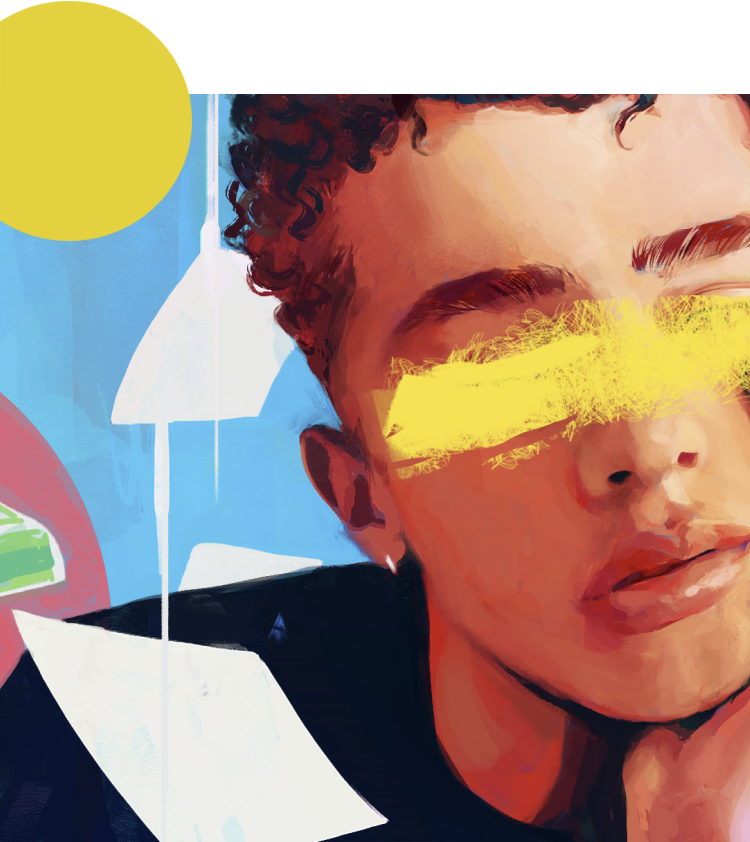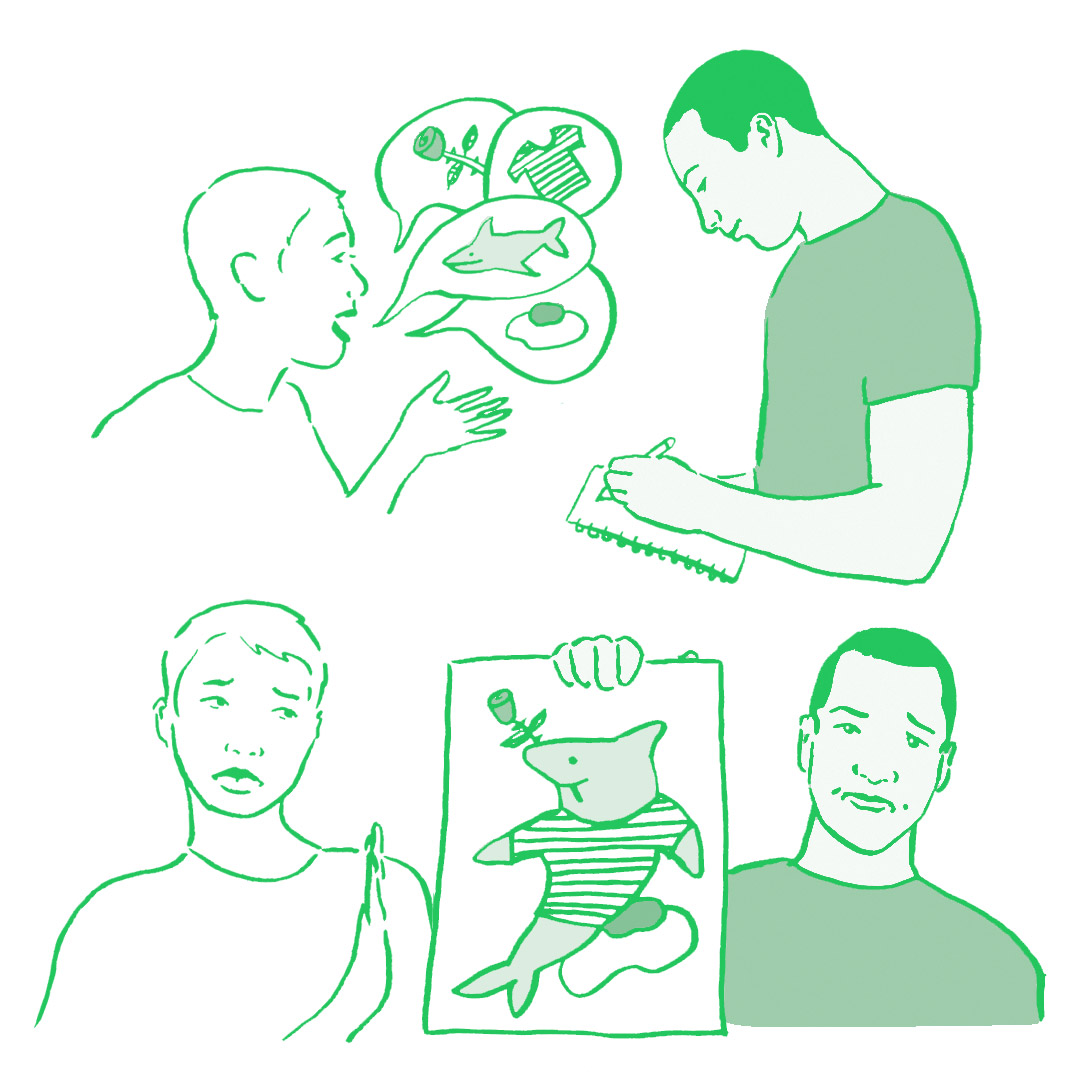04 Demystify Feedback
Brace yourself—it’s time to talk about the dreaded F word. Feedback can be a delicate process for illustrators and clients: From an illustrator’s perspective, receiving criticism can be emotionally challenging, because our work is often closely tied to our values and self-worth. For clients, especially those with no artistic background, it can be hard to know how to give the type of clear, actionable feedback illustrators need to move forward with their work. At Airbnb a huge part of our jobs is determining the best ways to deliver coherent feedback. Ultimately, a productive feedback cycle is what can make an illustration go from good to great, so knowing how to guide the process is an invaluable skill to keep in your toolkit. In this section, we’ll explore how to address even the toughest feedback in ways that will allow you to deliver your best work possible—and, most importantly, ensure that both you and your client have a voice in the process.
- Practice receiving and responding to difficult feedback
- Turn unfocused feedback into actionable next steps
- Gain insights from the larger industry and Airbnb Design
“The process of constant changes, back and forth, reiterations take the longest since different people have different opinions, and they may not take your suggestions seriously. And that prolongs projects.”
How to Handle 4 Types of Tricky Client Feedback Warm Up
An effective feedback process is crucial in a project’s final stages. If you’re lucky enough to receive clear, actionable comments from a client, you’re likely to have had a happier experience and done better work overall. On the other hand, poorly-constructed feedback can have the opposite effect, derailing deadlines, eroding sanity, and souring valued client relationships. Here, we’ll outline four types of client feedback that can be especially tricky to navigate, exploring useful tips for handling each. Ready to learn more? Head over to this section’s Deep Dive for a detailed look at this crucial (and often complex) process.
How to Handle 4 Types of Tricky Client Feedback
01 Vague.
Vague feedback is emotional rather than concrete (“this feels off,” for example, or “I don’t know why, but I just don’t like it”). If you’re on the receiving end of comments like this, ask your client specific questions about color, texture, and composition. Once they’re able to articulate what doesn’t feel right, you’ll be able to identify your next steps forward.
02 Conflicting.
A client’s feedback is conflicting when it doesn’t align with the instructions you received in your original brief. Instead of endlessly iterating on new directions, have your client verbally explain to you what they’re looking for. If they’re unfamiliar with illustration, give them the vocabulary they need to be as clear about their vision as possible. Follow up every conversation with an email summarizing what you agreed on, so you can reference it later.
03 Narrow-minded.
You may encounter feedback that doesn’t align with your values, like being asked to portray a woman as thinner. Depending on the feedback, you might decide to stop working with a client and make space for work that is more in line with your values, which is perfectly OK. If you’d like to have a conversation about feedback you find narrow-minded, you can use templates and info in our Deep Dive to learn how to handle these tricky situations.
04 Out of scope.
This type of feedback arises when a client requests major changes after a project has reached final stages. You can get ahead of out-of-scope feedback early on by educating clients on the difference between big and small edits. At the same time, set expectations about how timelines are affected if major feedback is requested too late in the game. (The Client’s Guide to Revisions template can help you explain what to expect during the revisions process.)
Takeaway
Frustrating feedback is never fun. But we’ve learned there are ways of handling uncomfortable situations that can help you keep a project moving, and produce client-pleasing work without sacrificing your values. It’s all about taking the time to help clients articulate their wants and needs—they’ll appreciate the effort, and you’ll both feel more confident about the path ahead.
Mastering the Feedback Loop Deep Dive
In our research for Tyrus, we spoke with hundreds of illustrators who told us that receiving clients’ critiques made them feel anxious and defensive—like inexperienced art students rather than qualified professionals. On the other hand, as clients ourselves, we know that this process can be extremely stressful for those giving feedback as well. This stress doubles if your client is unfamiliar with the way illustrators work. But productive feedback is essential to the successful completion of a project—so what can you do when the comments you’re receiving aren’t helpful, or worse, when a client asks you to compromise on your personal or artistic values?
In this Deep Dive, we’ll take a closer look at the four types of tricky client feedback outlined in our Warm Up, and explore how each can be addressed in a way that minimizes misunderstanding. Our goal is to empower illustrators to view this process less as something to dread and more as an opportunity for creative growth.
The Problem
A unisex skincare line is looking for a header illustration they can use for the launch of their new website. They’ve asked for art that showcases their full range of products, while also reflecting a focus on natural ingredients. The initial stages of the process have gone smoothly so far, but when it comes time for feedback, you find yourself receiving unproductive comments that make it difficult to solidify next steps.
The Solution
Tip 1: Address vague feedback by asking specific questions.
As mentioned in our Warm Up, vague feedback is imprecise and often centered around a client’s emotional reactions to a piece of work. These types of comments rarely contain actionable suggestions. Examples include statements like, “this doesn’t get me excited,” “this feels off,” or “I’m just not sure I’m vibing with this.”


How this could go wrong
After establishing a deadline and receiving a project brief, you return to your skincare client with a first pass at their new header. Their response? “I’m not sure, something about this feels off-brand. Can we see another sketch?”
Here, the client isn’t specifying what they feel would be on-brand. Instead, they’re asking you for more work without any additional direction, hoping they’ll know the right piece of work when they see it.

How to get it right
Often, a client thinks they know exactly what they’re looking for; then, when the work starts rolling in, minds start changing left and right. Help clients stay on track by asking hyper-specific questions about color, texture, and composition. Explain that this will help you identify the actions you should take next. After all, you can’t act on a comment like, “this doesn’t feel right,” but you can act on one that’s slightly more detailed: “this doesn’t feel right because the color feels too saturated.” In the end, it’s much easier to have a conversation like this than to devote the time and energy required for needless rounds of additional exploration.
Tip 2: Address conflicting feedback by helping clients expand their creative vocabulary.
Unlike vague feedback, conflicting feedback often comes with lots of actionable suggestions—but ones that feel at odds with the direction you received in your original brief. This can happen for a variety of reasons: sometimes a client is unaware of the many moving parts of a project; other times, they may have kicked off with you too soon.


How this could go wrong
Your skincare client’s brief contained specific directions to keep the look and feel minimal, so you submit an illustration that features simply placed products. However, after your client has had a couple of days to review, they get back to you saying that they’d like to see organic elements and a more maximalist look. Now you’re unsure what to prioritize: your original brief, or these newer, off-the-cuff instructions.

How to get it right
Verbal communication is key. Instead of doing multiple rounds of edits to accommodate your client’s changing vision, have a detailed conversation about what it is they’re really looking for. Ask the client if they need to reconvene with their team to better align this feedback to the brief. Provide them with a detailed clear list of which components you need clarity on in order to move forward. Often, clients who don’t have a background in illustration lack the vocabulary to express what they want to say. As the expert, guide the conversation by giving them words to describe what they have in mind: “When you say X, do you really mean Y?” When you’re done, send an email summarizing what you agreed upon so you can reference later if you need to.
Tip 3: Address narrow-minded feedback by offering inclusive alternatives.
Narrow-minded feedback asks that you modify elements of your illustration based on a client’s feelings about representing different skin tones, body types, gender identities, ages, and abilities. This type of feedback can be especially tough to hear—think, “can her waist be slimmer?,” “why does he look so feminine?,” “can’t we just use cartoon skin tones like purple or green?’”


How this could go wrong
Your client tells you they’d like to see an illustration featuring images of a person using their product, and you return with a draft depicting a black woman applying the product. Your client responds with a folder of images they’d like you to reference as inspiration for your next round, but every illustration shown is cartoonish candy-colored skin.

How to get it right
It can be nerve-wracking to talk about diversity and representation. But as an illustrator, you have the power to help guide the narrative of any assignment that comes your way. When a client is fearful of representing real people, take a deep breath and have a conversation with them about what’s driving that fear. Not all clients will be interested in having these conversations. Assess whether your client has shown signs of openness and transparency before sending an email. Logistically, it's also important to be honest with yourself about whether you’re okay with potentially losing a client. Sometimes we’re far enough in our careers to part ways with those who aren’t a good values match. Other times, we’re not sure when our next job will be and have to be more strategic in what we express.
Be an advocate for depicting people in all their many, true-to-life forms by letting clients know that this approach not only looks and feels better on the page—it humanizes and differentiates their brand.
Tip 4: Address feedback that’s out of scope by explaining the difference between big and small changes.
This type of feedback occurs when you’re asked to make significant changes to your work when you’re too far along in the process to do so. Acceptable requests during a project’s final stages include small, localized color changes; decreasing or intensifying texture; or adding or removing minor details. Unacceptable requests, on the other hand, involve major composition or layout changes, drastically different color explorations, or the addition or removal of elements that would foundationally change the image narrative.


How this could go wrong
You’re nearing your due date and submit a second-to-last draft to your client for final comments. Your illustration features a pink color palette, but your client gets in touch the next day asking for a complete color palette change and additional objects—a change that would require more time than the original schedule allows.

How to get it right
Let clients know early on what the difference is between a foundational change and a final tweak—and explain that significant last-minute revisions will require additional time and budget. It’s up to you to set your boundaries with the client before you start a project. We know these boundaries can be different for each illustrator and each project, so take the time to self-assess where you can be flexible in the process and where you can’t. (The revisions template can help you break down that process.)
Conclusion
Dreading the feedback process? We hear you. It can be incredibly frustrating to put in your best effort, only to hear that your client doesn’t feel your work is quite right. But rather than tackling endless revisions (or reacting emotionally in a way you may regret later), take time to ask questions, provide examples, and encourage clear, consistent communication between all parties involved. Perfect these skills now and chances are, your clients will wonder how they ever worked without you!




